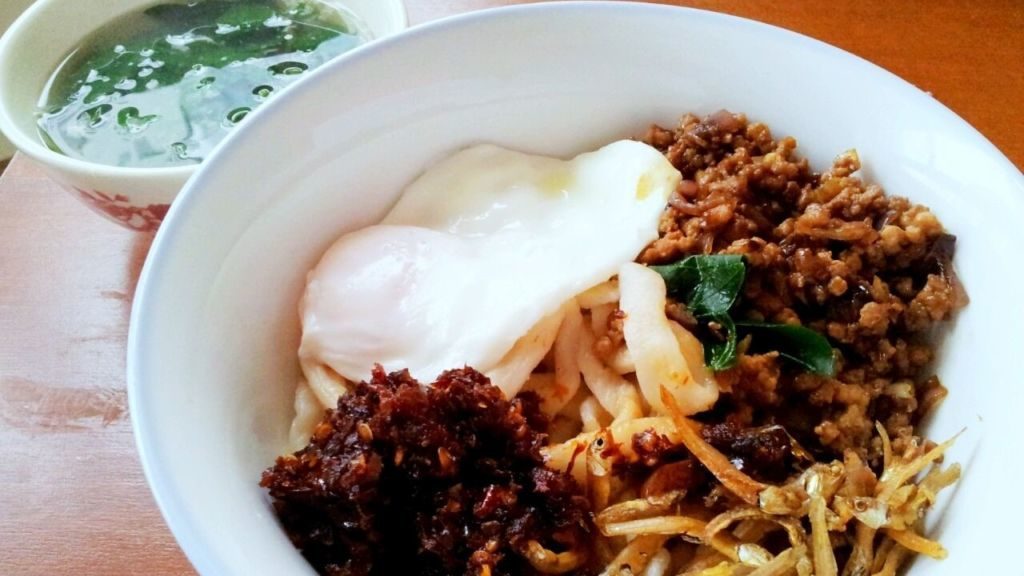Like your noodles with a little extra texture and taste? How about having your noodles spicy? If you like how that sounds then, you’re going to love chilli pan mee. Today, we introduce you to the classic Chinese noodle dish that comes in many styles of noodles, ingredients and soup bases.
What is Chilli Pan Mee?
Chilli pan mee is the spicier variant of the famous Chinese noodle dish, pan mee. This dish often provides two types of noodles – fine and stringy like typical noodles, or flat and thin rectangular strands like kuey teow dishes (but are more firm and solid).
Unlike the classical pan mee, chilli pan mee is often served dry, topped with minced pork, anchovies, fried onions and poached eggs. The egg is meant to be mixed into the dry pan mee noodles to provide more flavour.
As the name suggests, chilli pan mee is usually served with dry chilli or sambal. In most cases, the shops would stir chilli into the drained noodles before topping them with additional ingredients to give the noodles an aromatic spicy taste.
Chilli pan mee is considered one of the healthier Chinese dishes, but the classic soup pan mee is even healthier due to the plain yet flavourful ingredients.
History of Chili Pan Mee
Chilli pan mee has its roots in the Hakka and Hokkien style pan mee. The dish itself originated from Hakka- or Hokkien-speaking areas in China but soon came to be known in Singapore, Taiwan and Malaysia as well.
There are little differences between the pan mee cooked from these two roots aside from how they make the noodles and the main ingredients used.
The Hakka style pan mee would involve chopping away at the sides of a block of dough to make the noodles, while the Hokkien style pan mee is made by tearing out small pieces from the hand-kneaded mixture.
When pan mee was first introduced in China, there were no dry or spicy variations such the chilli pan mee we know and love today. The dish has a soup base, which made pan mee a distinguishable meal from other noodle dishes. The ingredients may differ between cultures, but two main ingredients are always found in traditional pan mee – mushrooms and anchovies.
The exact type of mushrooms or anchovies may differ, but these ingredients are usually included in the stock base. The mushrooms are often dried before they are added to the broth, while the anchovies are fried to a perfect crisp and served last on top of the noodles to preserve its crispiness.
It is the Hakka-style pan mee that initially provided options for soup and dry noodles. Chilli pan mee soon became a new pan mee variation, possibly stemming from our local’s love for spicy foods.
Today, chilli pan mee is a popular dish in Malaysia, especially in Klang Valley. However, you can also find this dish in most states in Malaysia.
Types of Chili Pan Mee
There aren’t many variations of chilli pan mee since this dish is quite straightforward as compared to the differences found in traditional soup pan mee dishes.
If chilli pan mee isn’t for you, then we would highly recommend you to try the traditional soup pan mee dishes as they are, with their minced meat or fish soup base, vegetables and anchovies topping.
Where to Find Chili Pan Mee in Malaysia
Chilli pan mee is a widely available dish, so you can find them served in Chinese restaurants and food stalls. Usually, if you visit a hawker centre or food court, you will see a stand selling pan mee in their many variations – soup or dried, different noodle types and more.
Want something a little more authentic? How about ordering your next chilli pan mee from shops or restaurants that specialise in selling pan mee? The pan mee from these places can never go wrong in taste and flavour!
If you want to order Chili Pan Mee from foodpanda, Sabah Chili Pan Mee SS2 (Petaling Jaya) or Uncle Kin Chili Pan Mee (Pulau Pinang) are recommended.
